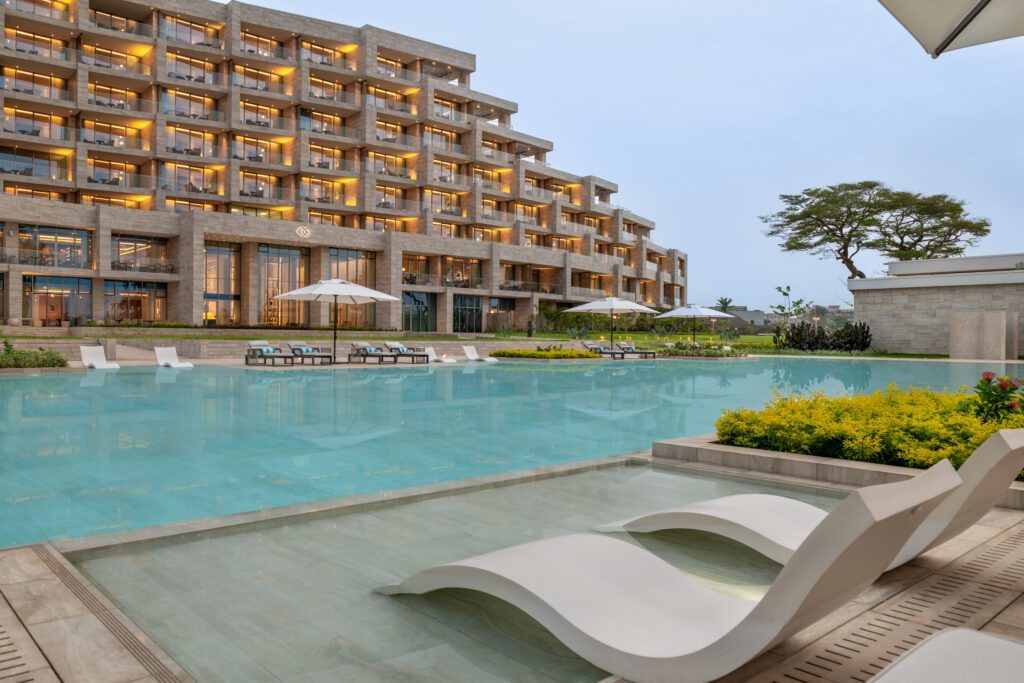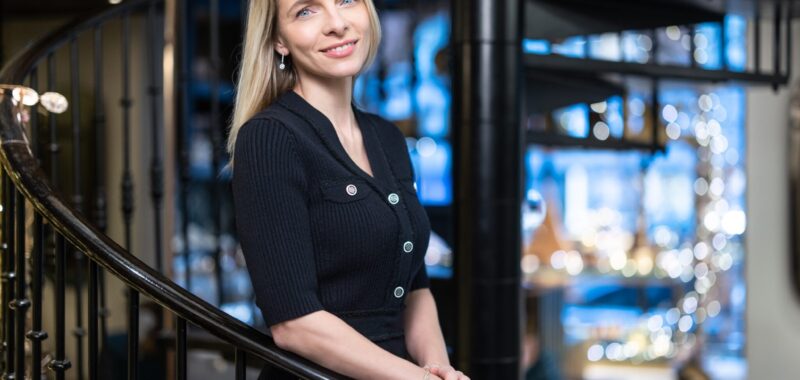Throughout its history, Sofitel has continuously reinvented itself to define — and redefine — what is possible in luxury hospitality. In celebration of the brand’s 60th anniversary this year, Sofitel has fully reimagined its position in the luxury market. This rising tide has lifted the ships of not just Sofitel, but also sibling brands Sofitel Legend, MGallery, and Emblems.
With a rejuvenated logo anchoring new brand pillars and an in-depth educational program inspiring increased engagement and emotional buy-in among employees, it’s no surprise that this reinvention has led to a major elevation of the Sofitel network. Major flagships like Sofitel New York, Sofitel Philadelphia, and Sofitel Montreal are undergoing major renovations, and in the next three years, Accor plans to open over 90 new hotels across the four brands.
SkiftX spoke with Maud Bailly, chief executive officer of Sofitel, Sofitel Legend, MGallery, and Emblems, about how Accor has simultaneously pushed the boundaries of luxury hospitality and built recognizable and long-lasting brands.
SkiftX: What’s your definition of luxury hospitality?
Maud Bailly: Luxury is really a matter of attitude. It’s a symmetry of attention between the way you make your guests and your employees feel. Everything needs to seem easy, whereas it’s a bunch of hard work backstage.
You can stay in a beautiful hotel, but if it’s emotionless, if it’s not seamless, if it’s not bespoke, it’s not luxury. On the other hand, you will forgive the aging bathroom at a luxury hotel if the service is magical. To me, luxury is walking on two legs: product quality and service culture. If you don’t walk properly on those two legs, you’ll fall.
There are many different kinds of luxury. Sometimes luxury can be a bit snobbish, cold, and arrogant. We stand for heartfelt, humble, passionate, generous, and slightly impertinent luxury. We train our people to leverage their emotional intelligence and authenticity as another more unexpected marker of luxury.
Let’s talk about that team training. What are your educational programs like?
We train our teams to blend luxury codes and emotional intelligence, leveraging authenticity and vulnerability as their superpower. You don’t need to spend millions to surprise people. If I offer you a 50-carat diamond without any emotion, you won’t give a damn. It’s nice, but you don’t care. But if I notice you’re tired when you arrive, and I take care of you by delivering a chamomile tea to your room with a handwritten note, and the next day I ask if you slept well because I know you had a hard flight, that’s special.
We started with a special development program for our general managers (GMs) called “I love, I live, I lead my brand.” It’s a very demanding deep dive around brand markers and our service culture standards. We’ve since expanded that training to all our employees. We are also designing leadership and empowerment programs that distill three main principles: high emotional intelligence, humble excellence, and distinguished presence. Our “Extraordinaire” program is a fast track for employees interested in becoming GMs within the specific culture of their brands.
Our staff has told us that the training hasn’t just changed the way they manage their teams and understand their brands — sometimes, it changes their personal lives. They’re learning to embrace vulnerability as a strength instead of a weakness and taking better care of themselves and their loved ones along the way. They’re listening with deep personal impact. We are a people industry. Our real first material is people.
How do each of your brands approach luxury differently? Let’s start with Sofitel.
Sofitel is about offering a little piece of France around the world. At Sofitel The Obelisk in Dubai or Sofitel Wentworth in Sydney, it’s both the same and completely different. It’s the same because you will find familiar French touches: fresh pastries and baguettes, brasserie dining, refined design, and the promise of French sleep with Sofitel MyBed. And yet each Sofitel is different because it offers a unique tribute to local culture. In Sofitel Reforma in Mexico City, French culture is embedded with the Mexican art of living, from food and mixology to music. At Sofitel Skipper Barcelona, the food concept combines French gastronomy and tapas culture. Sofitel arranges this beautiful encounter, this bridge, between French and local cultures.
For Sofitel Legend, it’s about offering a luxury experience that is steeped in history. Sofitel Legend Metropole Hanoi is in a hundred-year-old heritage building that was the first venue in Southeast Asia to project a film. Agatha Christie wrote “Death on the Nile” at the Sofitel Legend Old Cataract. The building is historical, and you are surrounded by the cradle of Egyptian civilization. Sofitel Legend The Grand Amsterdam used to be the city’s town hall. Sofitel Legend Santa Clara in Cartagena used to be a convent. Sofitel Legend Xi’an was the ancient Chinese capital building. Sofitel Legend Casco Viejo is on a UNESCO World Heritage site in Panama City.
They’re all stunning. You can imagine the power and magic of that history. Soon we’ll open a brand new Sofitel Legend right in front of the pyramids of Giza. It’s an exception because Sofitel Legend properties are all in historical buildings. This is a new construction and 60 percent of the rooms will look directly onto the pyramids. Open the window and history will literally blow into your room. That’s Sofitel Legend: living, sleeping, and eating with history in all its dimensions.
How do MGallery and Emblems approach luxury?
MGallery and Emblems are boutique hotel collections, so they stand for a more intimate luxury promise. Compared to 400 to 500 rooms at Sofitel locations, MGallery hotels have 50 to 180 rooms. Each MGallery is a destination in itself. Because they’re located in buildings that used to be coffee farms, tea houses, monasteries, police stations, tanneries, and newspaper companies, each one has a unique story to tell.
Emblems is a new brand for us. Our first hotel will open in 2025. Emblems is to MGallery what Sofitel Legend is to Sofitel. It’s a higher-luxury experience where each hotel is a distinct destination. Emblems will be focused on villas and apartments. You keep the intimacy of a boutique hotel, but with bigger spaces and more bedrooms to welcome guests.
Tell us about the repositioning that has brought these four brands under one maison, as it were.
Two years ago, we decided to take a brand-led approach with our luxury and lifestyle brands, and they now sit in dedicated organizations within Accor. I’m focused on four of those brands across a worldwide profit and loss (P&L), instead of 2,000 regional hotels which was my former remit before taking on this global role. The global scale is key to ensuring consistency, which is absolutely critical for luxury brand performance. If you want your brand to be powerful, recognized, and understood, you need to be consistent.
Brand repositioning is very demanding. It takes time, humility, and hard work. The first thing we did was travel the world to meet all the owners, GMs, and staff. I spent six months listening to them. Then we came back and asked ourselves the core of any brand-led organization: What do we stand for? What makes us different? How can we make sure our brands will last?
What new brand pillars did those repositioning conversations inspire?
First, we transformed our original pillar, the French touch, into the French zest. It’s a spirit more than a fact — French people know how to live well. Being French is a hedonistic capacity to embrace life in all its dimensions. The French zest is daring to surprise. It’s joyful, free, and slightly impertinent. At the same time, it’s a tribute to leadership in beauty, design, culture, and fashion.

The second pillar is our heartfelt service culture. Sofitel relies on what we call Cousu Main, which is about valuing emotional intelligence and bespoke, unexpected touches. We even host a contest every year to honor the concierges and managers who have crafted the most amazing bespoke experiences for our guests.
The third pillar is about shining a light on our logo and its meaning. The two beautiful shapes intertwining and embracing each other represent the magic of cultural links. We are building bridges between cultures, and forming a beautiful global community based on tolerance and mutual enrichment.
The fourth pillar is sustainability, which unfortunately can be less obvious in luxury hospitality. I don’t want to wait for regulations to take a stand for luxury that respects the planet, fights against waste, and promotes diversity. As of today, 60 percent of Sofitel hotels are eco-certified. We are eliminating single-use plastics in the guest rooms and back of the house. Our pilot AI programs have allowed us to reduce food waste by up to 70 percent. Being deeply committed to sustainability has become mandatory for us.
How do you think the demands of CSR programs are impacting the luxury hospitality space?
Luxury hospitality should lead the way as a pioneer, proving that we can protect the beautiful experience of luxury and be much more responsible at the same time. To me, there is no other future than sustainable luxury. That doesn’t mean you are neglecting the culture or the beauty of luxury. We can have it all. It’s more demanding, but we have to start now. It’s urgent.
Take food waste, for example. Buffets are a joyful signature of the hospitality experience. But 30 percent of food production in the world is wasted, while one billion people are starving or food insecure. CSR is not just about the environment, it’s also about people. All our brands are committed to giving back to local communities and promoting diversity. We’re committed to promoting women, gender equity, and diversity everywhere.
To learn more about Sofitel, click here.
This content was created collaboratively by Accor and Skift’s branded content studio, SkiftX.

